Index


The first high-end P35 board in our lab
This is the first high-end P35 motherboard in our labs.
Is the P35 a worthy successor to the P965, or is it just a me too chipset?
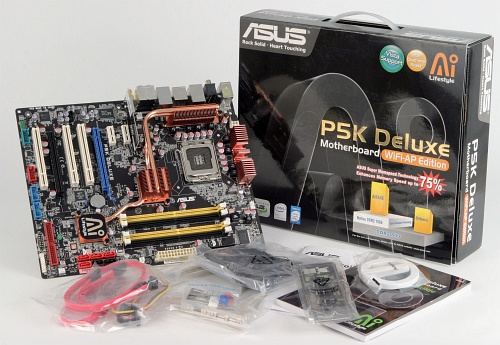
Features:
Intel P35/iCH9R
8-phase VRM
Agere L-FW3227-100
Analog Devices ADI 1988B
Marvell 88E8056 PCIe network MAC
Realtek RTL8110SC PCI network MAC
JMicro JMB363 SATA II RAID 0, 1/IDE controller
Winbond W83627DHG-A Super I/O controller
passive cooling of chipsets/VRM
8Mb BIOS, version 0311
Mainboard Revision: 1.00G
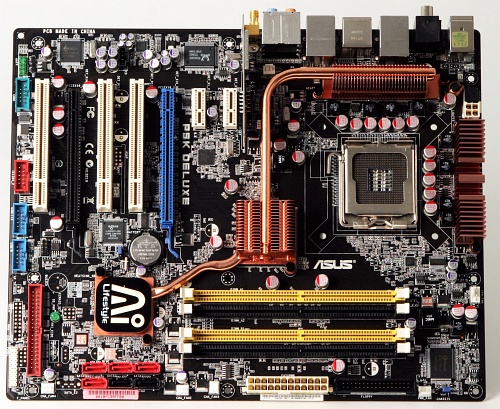
Slots:
1x PCIe x16, 1x PCIe x16 @ x4 speed
2x PCIe x1
3x PCI
Memory:
2x Dual-Channel DDR2-slots for PC2-5400U/PC2-6400U memory up to 8GB
Storage:
6-Port SATA II featuring RAID 0, 1, 5, 0+1, JBOD
1-Port IDE
2-Port eSATA II
Backpanel ports:
1x PS/2 keyboard
2x eSATA II
2x Gb LAN
1x Firewire
6x USB 2.0
7.1 Audio analog
1x SP/DIF digital out
1x SP/DIF coaxial out
Accessories:
1x 2-port USB + 1-port Firewire bracket
4x SATA cable (2 angeled 90°)
1x HDD-power to 2x SATA power cable
1x Floppy cable
1x IDE cable
1x ASUS Q-Connetor Pack
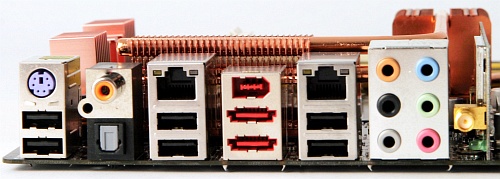
BIOS features:
Bus Speeds: Auto, 200MHz to 800MHz in 1MHz increments
Memory Ratios: Auto, fixed ratios: 1:1, 1:1.2, 1:1.25, 1:1.5, 1:1.6, 1:1.66, 1:2 depending on FSB
DRAM command rate: Auto, 1T, 2T
DRAM timing control: Auto, manual
PCIe Frequency: Auto, 100 to 150 MHz in 1MHz increments
Transaction Booster: Auto, disable, enable
Clock Over-Charging Mode: Auto / 700 / 800 / 900 / 1000 mV
CPU Clock Multiplier: Auto, manual
Core 2 Duo: 6x-11x in 1X increments - Core 2 Duo, downwards unlocked
Core 2 Extreme: 6x-16X, downwards unlocked
CPU Voltage: auto, 1.1000V to 1.7000V in 0.0125V increments
CPU Voltage Reference: Auto, 0.63x, 0.61x, 0.59x, 0.57x
CPU Voltage Damper: Auto, disable, enable
CPU PLL Voltage: Auto, 1.50V to 1.80V in 0.10V increments
DRAM Voltage: Auto, 1.80V to 2.55V in 0.05V increments
FSB Termination Voltage: Auto, 1.20V to 1.50V in 0.10V increments
North Bridge Voltage: Auto, 1.25V to 1.70V in 0.15V increments
North Bridge Voltage Reference: Auto, 0.67x, 0.61x
South Bridge Voltage: Auto, 1.05V, 1.20V
Layout:
The colour scheme is quite pleasing, a black PCB with yellow and black memory slots and red and black SATA connectors
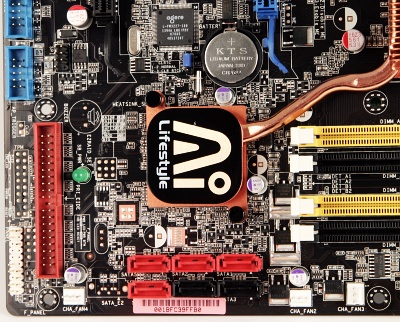
The ASUS P3K Deluxe is of course an "all-solid" design, and was expected initially at a €200,- price tag.
The voltage regulator is an 8-phase analogue part, although we would have prefefred a digital VRM. The power connector is positioned under the memory slots. The 8-pin CPU power connector is well placed on the outer edge of the board next to the CPU socket. The CPU area is clear, so mounting a big coolers is easy.
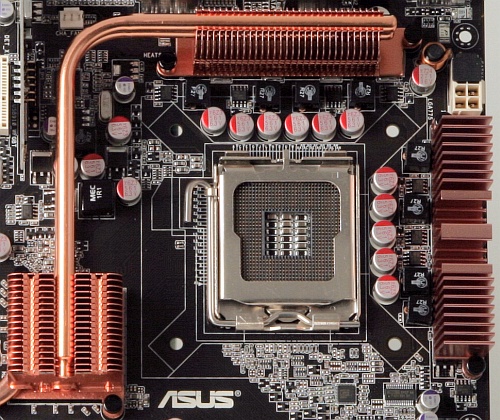
The ICH9R supports six SATA II ports, but lacks support for IDE. The red SATA ports are SATA master, while the remaining black ones are SATA slaves. We have no idea what the slave setting is used for, but maybe some hard drives are configurable to work with slave controllers. The JMicro JMB363 provides two eSATA II ports for external drives and one internal IDE connector.
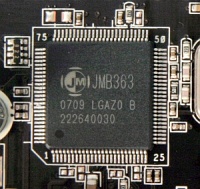
Network connectivity is provided by one Marvell 88E8056 via PCIe and one Realtek RTL8110SC via standard PCI. Gigabit Ethernet via PCI is not satisfying for an enthusiast board. An Agere L-FW3227-100 FireWire controller provides two ports of FireWire 400. Asus is using an audio codec from Analog Devices, namely the ADI1988B.
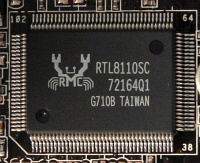
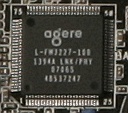
The case connectors are not colour coded, but ASUS provides a Q-connector panel. You can connect all the wires to the Q-connector and then attach this to the board, instead of having to fiddle around inside the case.
The configuration of the slots is not perfect, as using dual slot graphic cards means that two PCI slots will be wasted.
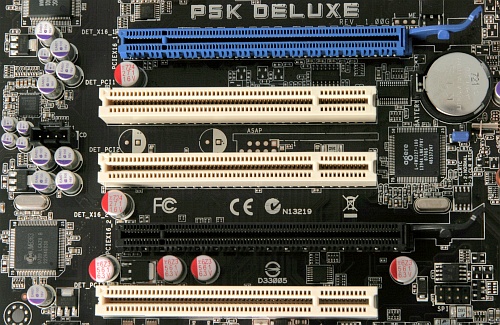
The heatpipe-construction keeps the temperature of the P35 under 60°C even at 1.55V . The extra cooling of the VRM part right to the CPU-socket did reach the 60°C mark. If not cooled properly the motherboard will have problems when overclocked. ASUS used heatpads instead of a better thermal compound. There is no chipset fan inclucded, so good case-cooling is paramount.
Testbed:
Motherboard:
ASUS P5K Deluxe/Wifi-AP (provided by ASUS)
Intel P35/iCH9R
CPU:
Intel Core 2 Duo E6700 (provided by Intel)
CPU-Cooler:
Scythe Andy Samurai Master (provided by Scythe-Europe)
Memory:
Kingston 2GB PC2-9600U Kit KHX9600D2K2/1G (provided by Kingston)
CL5-5-5-15-CR2T at 1.90V
Graphics Card:
AMD ATI Radeon X1950XTX (provided by AMD)
Power supply:
Silverstone Element SF50EF-Plus (provided by Silverstone)
Hard disk:
Western Digital WD4000KD (provided by Ditech)
Case fans:
SilenX iXtrema Pro 14dB(A) (provided by PC-Cooling.at)
Scythe DFS122512LS
Chipset:
The successor of the P965, is only slightly faster, with the only difference being support for 45nm CPUs and DDR3 memory. With prices sky-high, DDR3 is not an issue as yet.
BIOS:
ASUS has choosen an AMI BIOS. The overclocking settings are in the same menu and this time it's very user-friendly.
FSB overclocking:
We did of course try 500MHz, which was possible even on some P965 boards, but the sceen remained black. With 492MHz we could see the boot-screen, but booting was impossible. Reducing the FSB to 485MHz, was the maximum stable setting to run some test. This is not that bad, but we expected more.
Memory overclocking:
The board worked up to 1,200MHz without any problems, but we ran into some performance issues that we can't quite explain. The faster the memory setting the slower the results. This may be a bug in the 1.00G version of our board or possibly the BIOS. Meanwhile, ASUS has released a 1.01G version and other reviews doesn't report of such an issue, so we suppose ASUS fixed it in the new revision. Our board did not like to run with 1T setting and even standard PC2-6400U settings with CL5 would not run at 1.80V, we need to increase to 1.90V for stable operation.
CPU overclocking:
While the lower overclocking settings up to 333MHz x 10 didn't cause any problems, we ran into some isses when we used 366MHz x 10. We were disappointed with the P5NT WS board, because we needed to increase the VCore to 1.5375V, but on the P5K it got worse. We needed to increase the Voltage to 1.5500V, because the board would not work stable at lower settings. The VDrop was inside 50mV most of the time, but the sensor resolution of the Winbond chip is only 0.016V, so an exact messurement is impossible. 1.5500V resulted in 1.512V in Everest. The 3,733MHz setting was not possible, as the system wouldn't run stable.
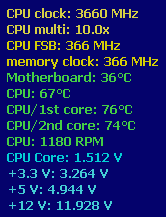
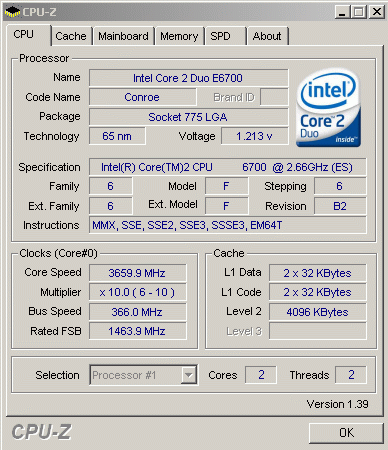
Before benchmarking we checked the reference frequency. At 266.66MHz and 333.33MHz FSB the board was slightly overclocked, so we re-calculated any benchmarks results to "should be" frequencies.
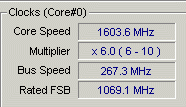
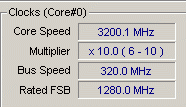
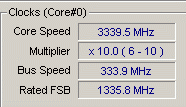
Benchmarks:
We didn't bother with synthetic benchmarks, because they won't tell you anything interesting, we concentrate on real world applications, especially multimedia encoding. Everest will report above 9,300MB/s and SiSoft above 7,200MB/s when benchmarking memory-reads.
Gordian Knot/XVID 1.1.2:
For our Gordian Knot testing we took an PAL epsiode from "Babylon 5" with a length of 41 minutes, 57 seconds and 8 frames.
We tried to "emulate" the most common usage of Gordian Knot:
1st: We have a perfect master, so we only de-interlace the content and resize it, without any other manupulations, we marked this as "fast".
2nd: You get bad mastering on many DVDs, especially "old" stuff or when the studios are in a hurry for the release. In this case you like to improve the picture quality, which is done by filtering the content. You can choose from tons of filters for any purposes you can think of, we only used the most common "undot", "FluxSmooth" and "MSharpen". Of course we also de-interlaced, filters were done before any resizing took place (which is slower). We marked this as "slow".
If you need more infos about filters, we recommand reading the doom9.org forum.
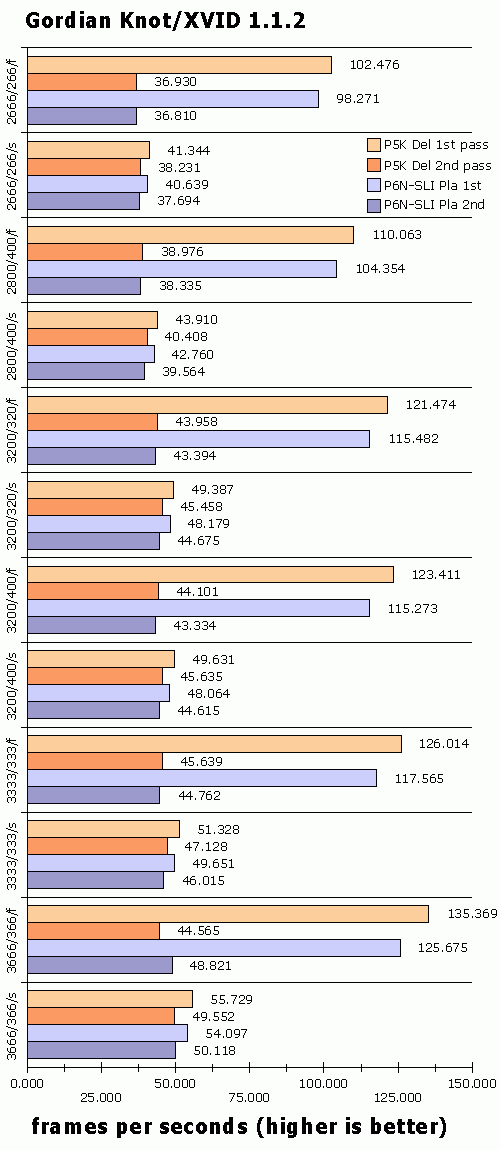
As described two pages earlier we ran into some performance issues when using faster memory settings, so we decided to do a complete benchmark with our Gordian Knot/XVID 1.1.2 test. We can't explain, why it happened. Even by setting all memory timings manually didn't improve things significantly. Our only guess is that the board introduces massive latencies. If this is an bug of the board itself or can be fixed with a BIOS upgrade is unclear. We will try to get a revision 1.01G board, maybe it's a hardware issue.
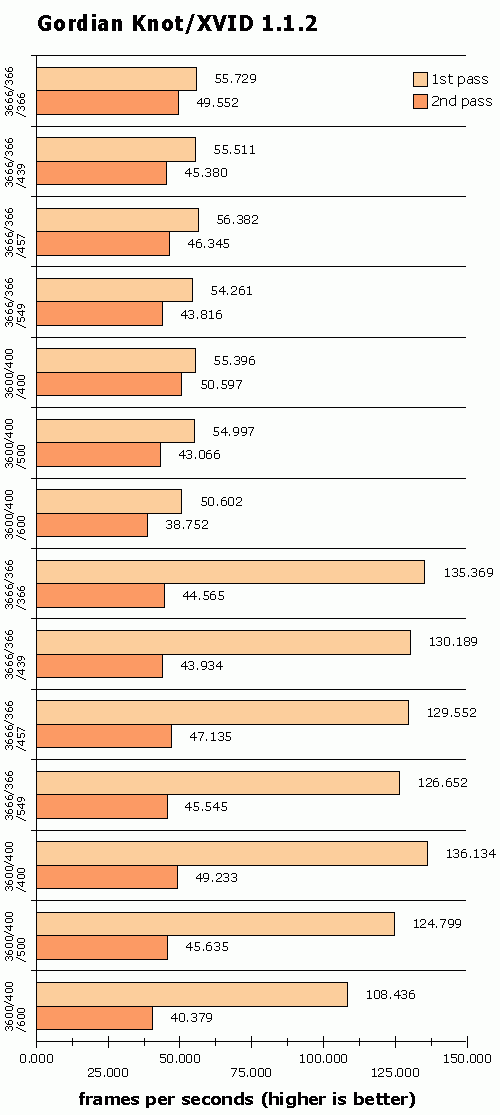
LameMT:
The same episode we encoded, we used for our MP3-testing. We don't recommand using MP3 for encoding, because AC3 can do the job better, but nearly 42 minutes gives us approximately the length of any given album.
A measurement in seconds, as many sites do, is useless, because the differences are too small. So we used the built-in play/CPU ratio, this means the CPU is encoding x-times faster then the track-length. Fast memory does not play an important role here. For your convenience we show you also the single-threaded benches, they will be produced with any other L.A.M.E. version, because only lameMT can do more than one thread and take advantage of a second dice.
We used this setting: lamemt --vbr-new -q 2 -V 2 -m j --strictly-enforce-ISO --resample 48
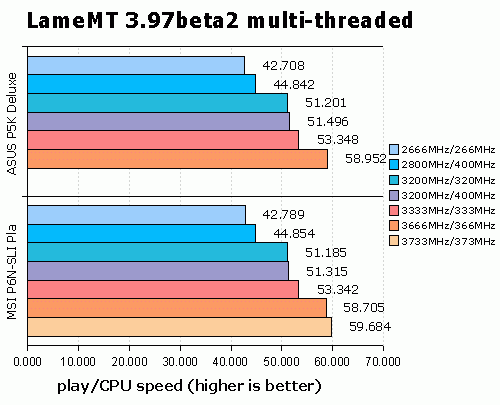
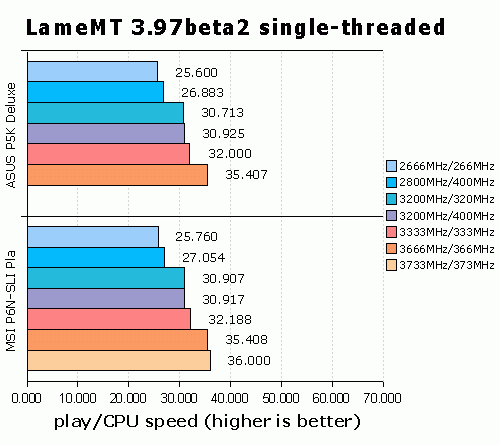
Power-Consumption:
We also checked the maximum power-consumption with the Realtek Gigabit and WLAN disabled.
The idle power is about 10W higher than other P965 boards, this may be caused by the VRM, which is more inefficient when running idle.
The power-consumption increased at the 3,660MHz setting, because we needed to increase the VCore to 1.5500V.
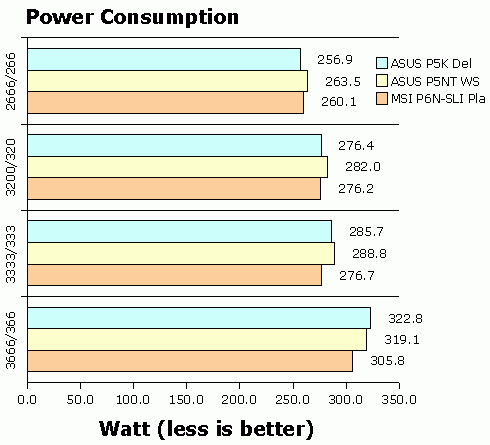
Conclusion:
For an enthusiast board the configuration is questionable, hardcore-overclockers will not be very satisfied when high CPU-clocks can't be reached. Meanwhile, other manufactures have released their highend boards and are selling them for about €40,- to €50,- less, Wi-Fi is not an argument for such a high price premium.
The board itself runs stable. We will look into the performance issues with faster memory. If you aren't intersting in overclocking and a decent CPU will suffice, it will do the job, but there are cheaper boards arround that will do the same job for less money. Hardware-overclockers should be cautious.
The ASUS P5K Deluxe retails for about €190,-.
